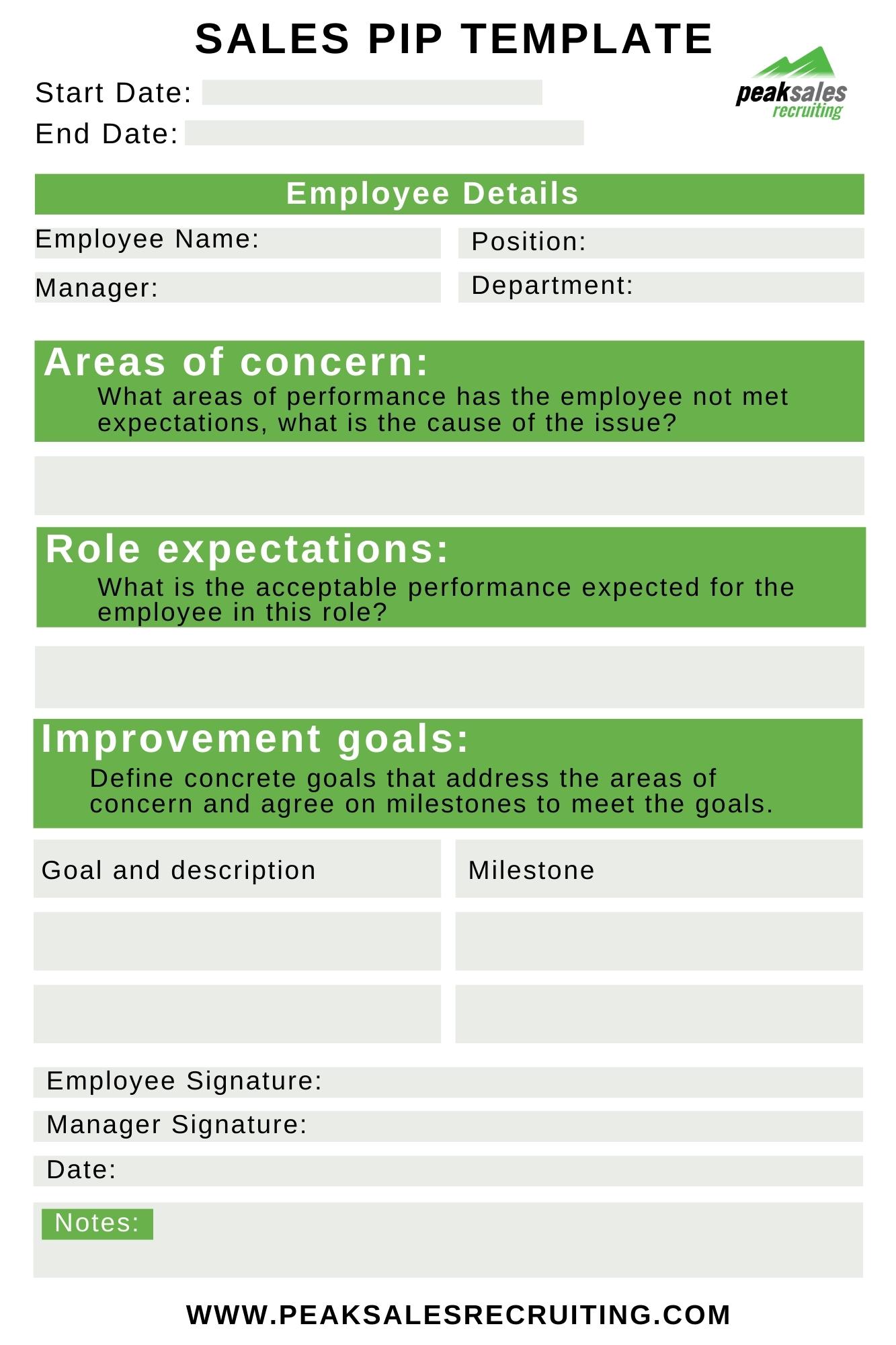What is a Sales PIP?
A Sales PIP —(otherwise known as) a Sales Performance Improvement Plan—outlines the steps an employee can take to obtain high levels of performance.
Sales PIPs use very clear metrics to define success within a predetermined time frame. PIPs are not intended to fix behavioral issues like inappropriate actions or attitude. Sales PIPs address chronic performance problems such as poor quality of work, missed targets, or a general failure to execute.
When a PIP is executed, it removes any element of surprise should a termination, demotion, or lateral move prove necessary. However, if executed properly, a sales PIP can increase employee productivity and performance.
Not all PIPs are created equal, so this article will examine some of the ways that managers can set them up for success. After all, a well-developed and executed PIP can save a business money and keep morale high.
Benefits of an Effective Sales PIP
When sales representatives consistently underperform, the quickest fix might be termination and a fast replacement. But putting them on a sales PIP is an important intervention that should come first.
So, for managers who want to do as much as they can to improve performance before replacing an underperformer, a PIP is a helpful tool. Here are some benefits:
1. The improvement of an employee’s performance. Subsequently, an improved performance could lead to increased productivity, revenue, and overall morale.
2. Transparency. A sales PIP, if done properly, will ensure that the employee and manager are on the same page and will hopefully result in improved performance. When the PIP’s timeline ends, the manager and employee must assess whether the specific success metrics have been met. If they have not, the manager has two options.
a) Either they can formally close the PIP and enact a termination, demotion, lateral move, or whichever other consequences were decided upon. Since such eventualities were clearly laid out during the PIP’s development phase, the outcome should not come as a surprise to the employee.
b) Or, if the employee seems to be making excellent progress despite missing overall milestones, the manager might choose to extend the PIP’s timeline.
3. Investment from the manager in the employee. Managers must ask themselves whether they are truly invested in an employee’s success, otherwise the PIP may be ineffective from the start. There’s a risk that the employee may conclude that the manager has already decided on termination, and that the PIP is the first step in the process, so they’ll begin looking for other jobs. The PIP is a team effort, so managers also need to put in effort to ensure its successful completion.
Note that misconduct, inappropriate behavior, and poor attitude are not what PIPs address. These issues should be corrected via other avenues, such as disciplinary action or termination.
It is important to fire salespeople with a record of underperforming, to safeguard the overall health of an organization, protect the brand, and limit revenue loss. But it’s important to balance the need for termination with opportunities for improving performance. Especially if the employee is eager to do so.
What Makes a Good Sales PIP
At a high level, sales PIPs must have clear metrics for success and include a timeline. A good starting point for managers is to consider the reasons for an employee’s underperformance. Thinking through the possible issues will help in understanding the employee’s potential, and guide what metrics should be used for the PIP. Once a PIP is signed, both the manager and the employee must work together to execute it. They should have regular meetings to discuss progress, monitor performance, and provide a chance for the employee to request support.
The employee’s role in the success of a PIP includes:
- Working to deliver on the PIP goals.
- Taking the lead to schedule progress meetings with the manager.
- Providing insights on the reason for poor performance, which may suggest the type of managerial support required for successful completion of the PIP.
The manager’s role includes:
- Understanding and addressing the root cause of poor performance. For example, if a decline in performance stems from lack of training, managers can investigate the possibility of providing official training opportunities as part of the PIP, or assigning a mentor to the employee. If unclear commission and/or bonus structure—or insufficient compensation—are at the heart of the problem, a manager should also investigate this, because it may have implications for the larger team.
- Keeping morale high. No one enjoys being put on a PIP. The manager should understand that the employee’s morale may suffer, and therefore managers should provide the necessary encouragement. Confidentiality is also critical and the employee must trust the manager to keep the process between just the two of them.
Beyond manager and employee teamwork, PIPS must be S.M.A.R.T: specific, measurable, achievable, relevant, and time-based. An effective sales PIP will be a detailed sales PIP and S.M.A.R.T goals will help you achieve that.
How to Write/Create a Sales PIP
When an employee has been identified as underperforming, you can begin creating your sales PIP. Before any writing occurs, it is best practice to give your employee a verbal warning.
Verbal Warning
Schedule a meeting to discuss the nature of the performance issues. Managers should provide specific examples of when the issues occurred and the actions needed to improve performance. In the spirit of working together, the employee should be given an opportunity to respond and provide additional information they believe relevant to help explain the issues. Perhaps the employee is having a personal crisis leading to their underperformance. Any employee information should be taken into consideration. Verbal warnings will be documented together with the employee’s input and kept in the employment file.
Written Warning
If performance does not improve or is not sustained after the verbal warning, employees will be given a written warning. This will reiterate and specify the nature of the issues, the actions necessary to improve the issues, the timeline to correct the issues and potential consequences if no improvement is achieved.
Written warnings may be of a 30, 60 or 90 day duration depending on the nature of the issues. A copy of the written warning will be maintained in the employment file. Employees should not be eligible for position transfers, promotions or compensation changes while under a written warning.
All written warnings will follow a standard template and be prepared or reviewed by HR before being communicated with an employee.
Sales PIP
The sales PIP will be a formal written document that will be approved by the manager, employee, and HR. The sales PIP can be delivered alongside the written warning, or after depending on the previous employee/manager discussions. The sales PIP should reference the original job description and company quotas and KPIs. No new goals should be introduced on the sales PIP with the exception of any training metrics which will be discussed during the verbal/written warning stages.
Some important sections to include on your sales PIP include:
- Role expectations: what is the expected performance of an individual in this role?
- Areas of concern: in what areas has the employee not met expectations and what is the root cause of the issue?
- Improvement goals: include a clear description of the goal and what the milestone will look like when achieved.
You can check out a detailed example here. One of the most important parts of a sales PIP is that you assign a timeline. Don’t be vague, “late next week” is not good enough, set an actual date. Be transparent about the repercussions if the goals of the sales PIP are not achieved.
Templates and Example
Download your sales PIP template here: https://www.peaksalesrecruiting.com/wp-content/uploads/2019/08/Sales-PIP-Template.pdf
Conclusion
PIPs work well for sales teams because sales as a function is highly measurable and has clear targets. This leaves little room for surprise in perceived performance and helps in the development of milestones and sub-milestones for an employee who wishes to improve their results.
Still, PIPs are a team effort. Sales leaders should be invested in the employee’s success and investigate ways to support them.
Firing an employee can be difficult, but when all other avenues are exhausted, managers may need to seek a replacement. Managers can also take the opportunity to reexamine their hiring process, which led to the poor hire in the first place. While the cost of training an employee can be cheaper than replacing one, the most cost-effective course of action is getting the hire right the first time.

relpost-thumb-wrapper
Related posts
close relpost-thumb-wrapper
Latest posts by Eliot Burdett (see all)
- 31 Must-Know Sales Follow-Up Statistics for 2024 Success – December 21, 2023
- 7 Success Characteristics That Define Top Performers – December 19, 2023
- 5 Reasons Your Top Employees Quit (Stop Doing This to Stop Them Leaving) – December 14, 2023





